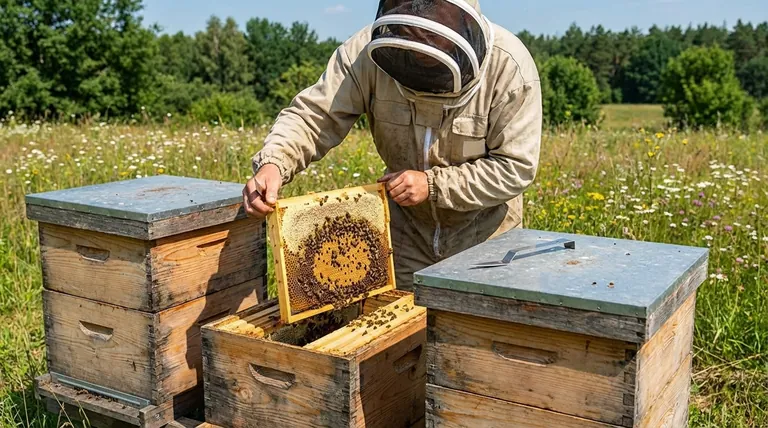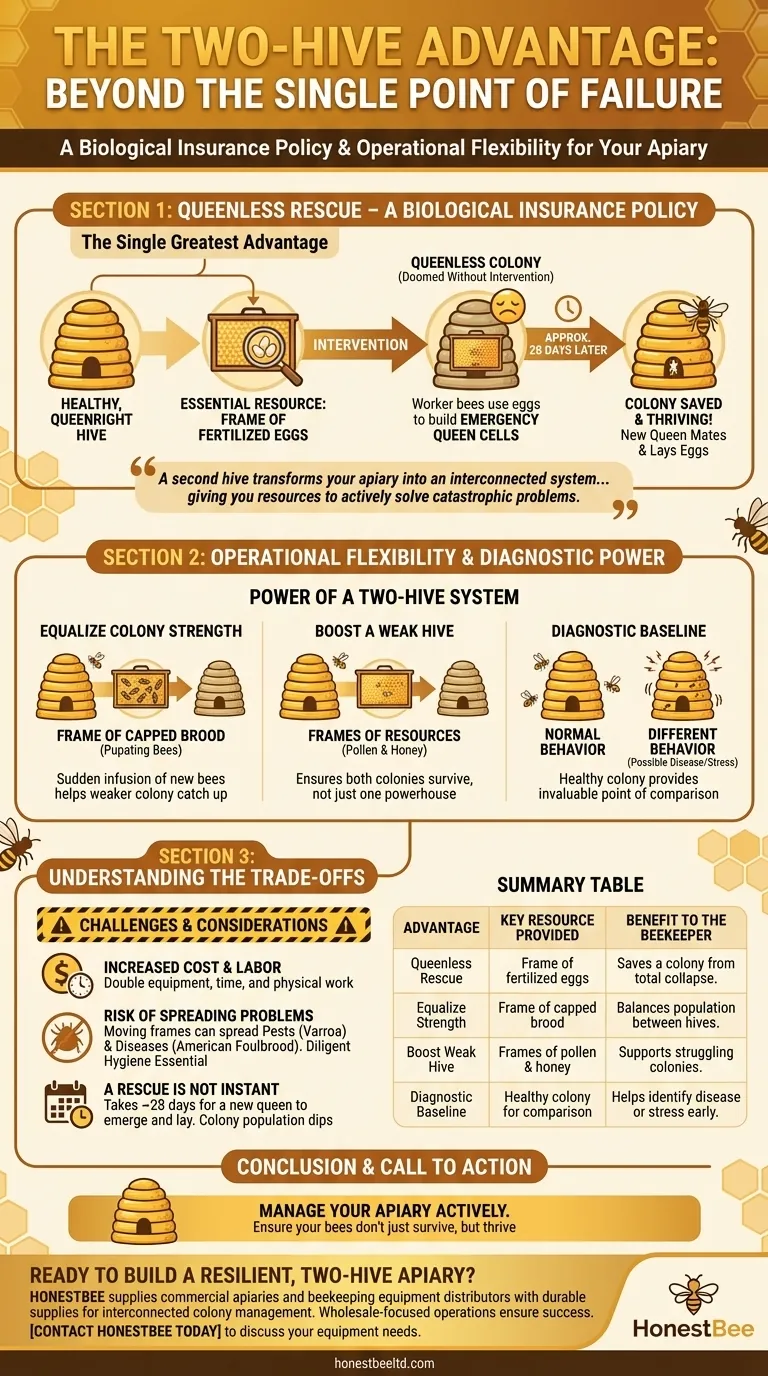The single greatest advantage of a second hive is that it provides a biological insurance policy against the accidental death of a queen. When a colony loses its queen, it loses its ability to reproduce and is on a path to collapse. A second, healthy hive provides the one resource that can save it: a frame of freshly laid, fertilized eggs, which the queenless bees can use to raise their own replacement queen.
A single beehive is an isolated unit, vulnerable to a single point of failure. A second hive transforms your apiary into an interconnected system, giving you the resources to actively solve catastrophic problems like queenlessness instead of just watching them unfold.

The Mechanics of a Queenless Rescue
To understand why a second hive is so critical, you must first understand the biology of a queenless colony. The entire colony's survival depends on a continuous supply of new bees, and only the queen can provide that.
The Countdown Begins
When a queen dies, the clock starts ticking. The colony has a workforce of adult bees, but with no new eggs being laid, that population will steadily decline as older bees die off. Without intervention, the colony is doomed.
The Essential Resource: Fertilized Eggs
Worker bees have a remarkable ability: they can create a new queen from any fertilized egg or very young female larva (less than three days old). They do this by feeding the larva a special diet of royal jelly, which triggers its development into a queen instead of a worker.
The "Frame of Eggs" Solution
This is where the second hive becomes a lifesaver. A beekeeper can go into the healthy, queenright hive and pull out a single frame containing fresh eggs. This frame is then placed in the center of the brood nest of the queenless hive.
The Bees Take Over
The worker bees in the queenless hive will quickly recognize the presence of these viable eggs. They will select several, build large, peanut-shaped emergency queen cells around them, and begin feeding the larvae royal jelly. The colony initiates its own rescue.
Beyond Queen Loss: The Power of a Two-Hive System
While saving a queenless hive is the most dramatic advantage, a two-hive system provides operational flexibility that makes you a more effective beekeeper.
Equalizing Colony Strength
It's common for one hive to be stronger than another. You can take a frame of capped brood (pupating bees about to emerge) from the strong hive and give it to the weak one. This provides a sudden infusion of new bees, helping the weaker colony catch up.
Boosting a Weaker Hive
Similarly, if one hive is struggling, you can donate frames of resources—not just brood, but also pollen and honey—from your stronger hive. This helps ensure both colonies survive and thrive, rather than having one powerhouse and one failure.
A Diagnostic Baseline
Is a hive's behavior normal, or is it a sign of disease or stress? Having a second colony provides an invaluable point of comparison. If both hives are acting the same way, it's likely a response to environmental factors like weather or nectar flow. If one is behaving radically different, it signals a problem that needs investigation.
Understanding the Trade-offs
A two-hive system is not without its challenges. Objectivity requires acknowledging the downsides.
Increased Cost and Labor
The most obvious trade-off is resources. Two hives mean double the initial equipment cost, double the time for inspections, and twice the physical labor for tasks like honey harvesting or moving boxes.
Risk of Spreading Problems
Moving frames between hives is a powerful tool, but it's also the primary way that pests like Varroa mites and devastating diseases like American Foulbrood can be spread through an apiary. Diligent inspection and hygiene are non-negotiable.
A Rescue is Not Instant
Providing a frame of eggs does not solve the problem overnight. It takes approximately 28 days for a new queen to emerge, mature, mate, and begin laying her own eggs. During this month-long period, the colony's population will dip, making it more vulnerable.
Making the Right Choice for Your Apiary
Ultimately, the decision to start with one hive or two depends on your goals and tolerance for risk.
- If your primary focus is risk mitigation and robust learning: Starting with two hives is the superior strategy. It provides insurance against colony loss and offers far more opportunities to understand and manage bee biology.
- If your primary focus is minimizing initial cost and labor: A single hive is a valid starting point, but you must accept the significantly higher risk of a total loss and be prepared to purchase a replacement queen if necessary.
Managing two hives fundamentally changes your role from a passive keeper to an active apiary manager, giving you the power to ensure your bees don't just survive, but thrive.
Summary Table:
| Advantage | Key Resource Provided | Benefit to the Beekeeper |
|---|---|---|
| Queenless Rescue | Frame of fertilized eggs | Saves a colony from total collapse |
| Equalize Strength | Frame of capped brood | Balances population between hives |
| Boost Weak Hive | Frames of pollen & honey | Supports struggling colonies |
| Diagnostic Baseline | Healthy colony for comparison | Helps identify disease or stress early |
Ready to build a resilient, two-hive apiary?
Managing multiple hives requires reliable, high-quality equipment. HONESTBEE supplies commercial apiaries and beekeeping equipment distributors with the durable supplies needed to manage interconnected colonies effectively. From hive bodies to frames and protective gear, our wholesale-focused operations ensure you have the tools for success.
Contact HONESTBEE today to discuss your equipment needs and ensure your bees don't just survive, but thrive.
Visual Guide

Related Products
- HONESTBEE Professional Long Handled Hive Tool with Precision Cutting Blade
- HONESTBEE Advanced Ergonomic Stainless Steel Hive Tool for Beekeeping
- Professional Dual-End Stainless Steel Hive Tool for Beekeeping
- Plastic Bee Hive Stand for Beekeeping
- Langstroth Bee Hives Bee Keeping Box for Beginners Beekeeping
People Also Ask
- Why do hive tools have a hole? Unlock the Secret to Efficient Beekeeping
- What are the basic tools for beekeeping? Essential Starter Kit for Safe & Successful Hive Management
- What are some common uses of a hive tool? Essential Multi-Purpose Tool for Every Beekeeper
- How should beekeepers handle bees when using a hive tool? Master Calm, Deliberate Techniques
- What is the hive tool used for? The Essential Multi-Tool for Every Beekeeper



















